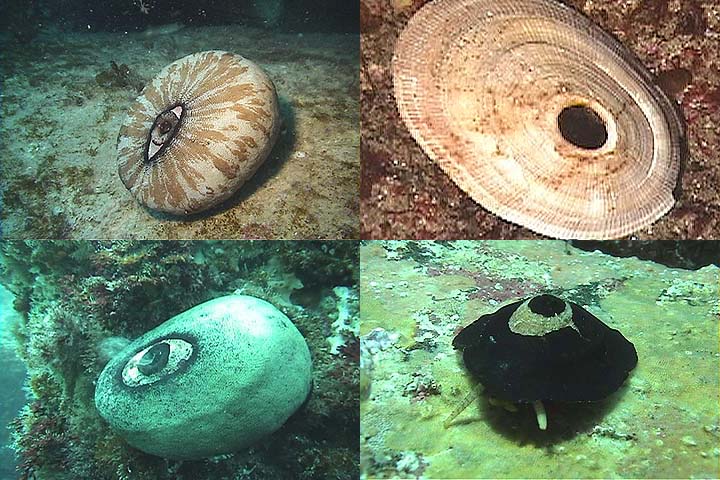

The giant keyhole limpet is a "primitive" snail closely related to the abalone. It is not one of the smaller "true" limpets commonly found on intertidal rocks. Although I do not encounter them underwater as often as I used to, over the past few months I observed a large one at the East End Quarry and a small juvenile underneath a rock at about 20 feet in the Casino Dive Park.
Although the shells are relatively small, up to 4" long, the animal itself extends well beyond the oval shell often completely obscuring it. The body may be up to 10" long. The shell's single large opening in the center of the radiating ribs is to allow waste products to exit gracefully without re-entering the gills or mouth area. The outer mantle tissue may be cream or gray color with stripes and spots of darker brown or gray pigment. It may also be a solid black in color like the juvenile I observed recently. The black pigment is known to rub off on those who handle it. The larger muscular yellow foot attaches the snail to the rocks just as an abalone would.
This species is known from Monterey Bay to Isla Asuncion off Baja California. Unlike its close relatives, not much is known about it since it was not harvested for food like the abalone. Giant keyhole limpets are primarily herbivorous feeding on seaweeds, but they will also take an occasional tunicate (a bit like the "vegetarian" who sneaks into McDonalds for a Big Mac, eh?). Scientist have to examine the gonads to determine whether they are male or female. Let's hope the keyhole limpets don't need to resort to that themselves. They probably use chemical senses to find an appropriate mate. They may be sexually mature at any time of the year.
While diving Anacapa Island about a year ago, I encountered several giant keyhole limpets of different colors at the underwater arch in Landing Cove. As I approached one of them, it began releasing its sperm or eggs into the water just as the brown urchins at Isla San Francisco in the Sea of Cortez en masse did last year. I didn't realize I had that effect on marine invertebrates... wish it worked as well for the females of my own species! Perhaps, as Morgan in the 1966 movie classic of the same name said "I was born into the wrong species."
Since it was a somewhat unusual discovery, I spent a large part of one dive with the juvenile giant keyhole limpet to observe it. It's overall size was about 2" with a shell slightly less than 1" long. I found it on the under-surface of a rock I turned over. I positioned it on top of the rock to get better lighting to videotape it. As I rolled the footage, it was obvious that the snail was trying to get back to the dark side... of the rock. Like many organisms that live under rocks, it had a negative reaction to sunlight and sought to avoid it by crawling to the lower surface. As I turned the rock over, and over, to film it repeated this process until I acquired enough footage. I carefully replaced it and the rock back in place right-side up.
When I first came to Catalina, I found a shell of this snail on the beach and wore it around my neck on a rawhide string (well, after all, it was the 60's). I later learned that coastal tribes often used the shell of this species as wampum or money. I wonder what denomination I had back then, and (if I find it packed away somewhere) what the exchange rate is today.
© 2004 Dr. Bill Bushing. Watch the "Dive Dry with Dr. Bill" underwater videos on Catalina Cable TV channel 49, 10:00 AM and 5:00 PM weekdays.

Mottled brown giant keyhole limpet from the East End
Quarry; shell of this species;
limpet on East Anacapa Island releasing
sperm or eggs from its central hole;
juvenile black-mantled limpet found in
the Casino Dive Park.
This document maintained by
Dr. Bill Bushing.
Material
© 2003 Star Thrower Educational Multimedia